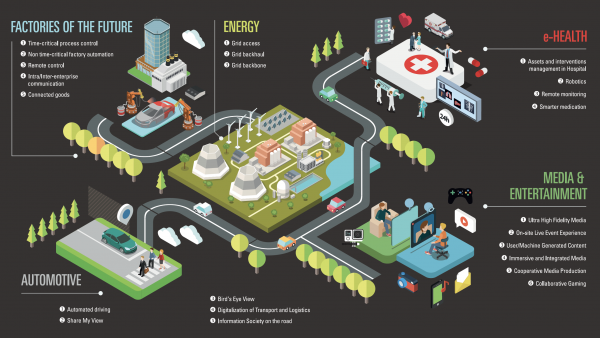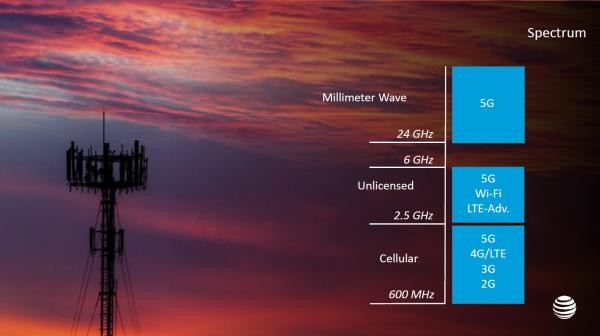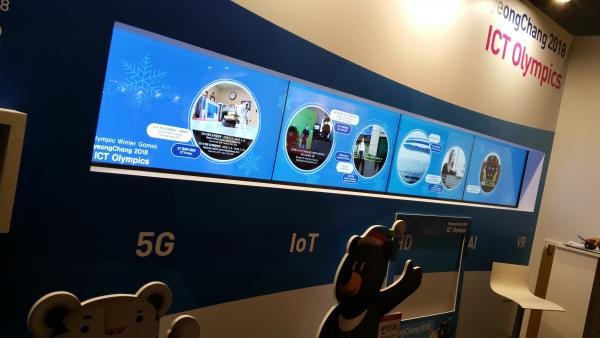The 5G, a simple evolution of the 4G?
It is not uncommon these days to see technologists and futurologists of all kinds come together for conferences and meetings around the theme of digital and its evolution. Very often, they give you unverifiable figures or truths that are only a few months old and will soon become obsolete. Will it be the same for 5G? The odds are that it won't be.
The 5G is not just the change of the little pictogram at the top of your smartphone's menu bar - which has seen the last few years the Edge, H+, 3G and other 4G icons scrolling by - which will be replaced as of 2020 by a "5G". This time, it's no longer a simple technological evolution, but a real industrial revolution that is on the horizon, and which will affect all industrial sectors, including the media sector.
This 5G promises to be the fuel of tomorrow's hyper-connected world. Gone are the days when we were content to imagine a slightly blurred future, now we need to prepare in concrete terms for the imminent arrival of this technology. The very powerful American microchip foundry Qualcomm has just presented its first test smartphone equipped with a component dedicated to 5G, heralding the upcoming release of smartphones from other brands with this new functionality. In fact, OEMs and manufacturers of terminals and components such as Ericsson, Nokia, Samsung, Huawai and Intel are already in the starting blocks.

A huge business estimated by Arthur D. Little at 1233 billion dollars in about ten years. In only 7 years, around 2025, no less than 214 million 5G connections will already be in place in Europe (GSMA association figures), and when we know that this type of wireless connection will be able to deliver performance close to that of fiber optics, our curiosity is inevitably put to the test.
This technology has been followed since 2014 by France Télévisions and presented at Roland-Garros with Frenchman Siradel, (now part of the Engie Group) is now in the final phase of standardization. It is built by the powerful telecom and digital industries. Some already speak, rightly, of a "disruptive technology", while others see in it "the dawn of the ambient Internet". What is certain is that 5G is set to change our daily lives in the coming decade.
Does 5G have competitors?
Strictly speaking no, since this standard was created from scratch by its own industry. According to analysts, 5G should be deployed very quickly, mainly in the US and Asia (China, South Korea, Japan). Nearly one billion users are expected to convert to 5G between 2020 and 2023, half of them in China (source CCS Insight).
It should be noted, however, that other digital transmission technologies, whether or not they are dedicated to IoT, have no plans to be phased out with 5G. They are numerous, at very low cost, without the need for a SIM card, even a virtual one, as will be the case in 5G. Let's mention Bluetooth for example, or home automation technologies such as Zigbee, Z-Wave, 6 LowPAN, Thread and why not NFC. All these solutions, also wireless, necessarily already equip one of your personal equipment. Other technologies for professional use such as Sigfox networks orLi-Fi and its light connection solutions will also compete with 5G for some IoT functions.
As for the very popular WiFi, it still has many years ahead of it with the future 802-11 ax WiFi standard, which promises close to 7 Gb/s theoretical in your home. There are rumors that some of these technologies are being considered for inclusion in the 5G standard. But nothing is done because the risks of opposition of economic models are strong between networks operated by Telecom players and neutral solutions rather from the field of consumer electronics products for sometimes identical uses, and which will be rather complementary to this 5G.
Which industries will be impacted by 5G?
It would be more logical to ask which industries will not be! We've already seen digital giants being built from scratch in just a few years thanks to digital technology, especially mobile digital. Well, imagine that with 5G, everything you've experienced is set to expand with, most likely, new players that will be added to the powerful digital industries.
5G won't just allow you to download your favorite movie in a few seconds (10 to 100 times faster than in 4G, all the same, since it aims at 10 GB/s - and much more in the lab). It will also be able to respond to the incredible evolution in the performance of embedded electronics, where billions of microprocessors, processing billions of instructions per second (MIPS) to run our digital everyday life, will be able to interconnect via 5G networks. We're still in the IoT field, but on a much more advanced scale than the pedometer that counts your steps and displays them on your cell phone?
In 5G, connections will sometimes be made at very low speed (NB-IoT) just for the transfer of an electrical state 1 or 0 or by low digital rates up to dizzying speed performances for demanding services. The 5G standard will be able to adapt to all cases of use: it is designed to be fast, extremely reliable for sensitive industrial environments, and it can be virtualized. Moreover, it is virtually latency-free, meaning that an order is immediately executed even when far away from its originator. Imagine an autonomous transport fleet manager: with the 5G, he will be able to guide his vehicle as close as possible to the last few meters of the loading dock. The Swede Ericsson demonstrated this a few days ago in Paris by guiding a vehicle hundreds of kilometers from the capital in real time.
La 5G, the next big digital thing : interview of Viktor Arvidsson (Ericsson)
Because 5G data transmission is so precise, a 5G antenna can almost "surgically" target a user on the street to give them the power of the service they require - instead of, as today, indifferently sending the signal 360 degrees around the telecom base station antenna. This is Beamforming, or Beamtracking.
The 5G standard is also intended to be energy-efficient, because the managers of future connected cities have to comply with environmental obligations and other operating constraints that will require these millions of objects connected in 5G to have a very large electrical autonomy.
Some examples of the industrial sectors targeted :
Tomorrow's factory, which sees 5G as an indispensable tool for remaining competitive and facilitating human labor while increasing industrial performance, from "machine-to-machine" transmissions to manufacturing line processing and transportation logistics, not to mention product distribution. Security, with its increased need for video surveillance and real-time image analysis, will also exploit 5G to better integrate cybersecurity into the digital economy. The transportation industry will also be heavily impacted by 5G, with the challenges of urbanization, transportation intermodality and the need to reduce CO2 footprints. Health will also benefit from 5G's advances in telemedicine, the arrival of self-monitoring systems for our health, and the problems of medical desertification and optimization of healthcare resources. Financial services (real-time tax processing, secure mobile transactions, e-wallet (digital wallet), other technologies linked to Fintech and, why not, equipment dedicated to virtual money) will also be impacted by 5G. The automobile, with, of course, the connected and soon-to-be-autonomous automobile, whose functional requirements, particularly in terms of security, will be based on the deployment of 5G networks. All carmakers are working on this, in France and around the world. Virtual 5G networks will be set up for the automotive sector, no doubt accompanied by information or digital entertainment services in vehicles, as demonstrated by the latest autonomous vehicle projects at the Frankfurt Motor Show. The planned end of internal combustion vehicles will also be accompanied by a major need for managing electrical energy resources, and the 5G interconnection of energy supply and demand will be crucial.energy, oil, electricity and other sectors are demanding new solutions for resource management, storage, distribution and monitoring, which can be provided by 5G.media and entertainment services, finally, are at the heart of 5G projects, some of which have already been pre-empt by the giants in the sector.

Launching 5G: what resources are required?
While 5G holds great promise, let's not forget that 5G needs the radio spectrum, i.e. the available frequencies, to operate. The technical infrastructure will be complex, but also very "intelligent", combining fiber optic and wireless networks. Interconnections of national, regional and local 5G datacenters are planned, and virtual networks (Slice) will be configurable in just a few minutes at the request of business customers.
Some major operators are even talking about 5G infrastructure sharing between competing operators, thus separating networks and services. In all cases, a significant need for frequencies is put forward. It is precisely one of the particularities of 5G that it can adapt to different frequencies in order to optimize its performance. This is a highly strategic subject, and only the competent administrations can help ensure, region by region, that 5G can use frequencies without interfering with existing services.
There are two main categories of frequency bands for 5G:

With this in mind, Brussels has entrusted CEPT (the grouping of the telecom administrations of the European states) with the development and harmonization of the technical standards needed to launch 5G in Europe. Complex international debates are open between industry representatives (NGMN, GSMA) and official bodies (ITU, CEPT) where industrial strategy and the need for regulation are intertwined to avoid Europe falling behind industrially in this strategic sector in the face of the Asia/USA duopoly. And time is running out, since the first tests (Orange, Free, SFR, Bouygues in France) and commercial launches of 5G in Europe are already announced for 2020!
Is television impacted by 5G?
To say that Television will not be impacted by 5G would be to deny the current role of the Telecom digital infrastructures that have enabled the current explosion of digital uses for the audio-visual sector. As Daniel Danker, Director of Video Product at Facebook, recently stated in Cannes, two billion people go to Facebook every day, and if video today represents half of the mobile traffic, it should reach 75% in just 5 years! And 5G is likely to amplify these trends, probably creating other giants, especially those from Asia, which are already being watched very closely.
Television is therefore primarily concerned by 5G, firstly because this technology is aimed at both fixed and mobile use (up to 500Km/h, it seems...), it can address an unlimited number of users (eMBMS) and can broadcast both linear and non-linear content. Secondly, because it targets all screens, including the TV, even without a SIM card in the receiver, as DTT does today.
If you are in a reception area no need for an external antenna it is in your screen, otherwise a simple 5G antenna at home will give you a connection speed equivalent to that of fiber optics, all without waiting for the digging of trenches in the street. Enough to seduce municipalities and telecom operators, if they consider this connection method to be more economical or faster.
Numerous tests are already underway, including those by Arqiva with Samsung and France's Ateme, which will test the broadcasting of 25 UHD 4K channels in 5G in a London neighborhood at the end of 2017. Korea will take advantage of the Winter Olympics to test 5G and 8K production. Japan's Sharp goes even further and is considering a complete 8K + 5G ecosystem with China's Foxconn. An ambitious project in line with the 500 million 5G users in China in 2023 that we announced at the beginning of this article!

The EBU, a grouping of European public broadcasting operators, also takes the subject very seriously. The structure underlines the interest of this technology in a context where 94% of public players already use the Internet to broadcast their programmes live. 5G would thus be a new growth driver for cross-media, multilingual, interactive, AR or VR formats. It will also, of course, allow the virtualization of TV production under IP. The German public TV research center IRT in Munich estimates that this technology could become a mass market as of 2025. In its latest publications, the EBU even goes so far as to project itself into an all 5G universe in the long term!
If the entire industrial sector concerned and all the European administrative authorities are sensitive to this subject, it is because they have understood that nothing will hinder the modernization of digital terrestrial data transmission. Regulations and economic models will potentially be impacted, and everyone is curious about the first tests of this 5G and its future potential. The powerful players in the Asia/US duopoly on 5G are being observed, players who intend to take advantage of this technological leap to prosper. The American operator AT&T recently reminded us in Paris, alongside Ericsson, of the role of the "Non Telcos Players" in this sector, where we already find the industrial giants in the digital, transport, automotive and other sectors, who are planning to offer their services on their own virtual 5G network.
While in California, Facebook is thinking about its future in 5G with its Terragraph and Telecom Infra Project, we can imagine that tomorrow's digital media will be very different from the ones we know today. As for France, let's bet that the major events to come (the work of Greater Paris, the 2024 Olympics, perhaps the 2025 Universal Exhibition) will be an opportunity to advance the deployment of 5G in France and that television will be able to make the most of it.
 Back
Back
 R&D
R&D











